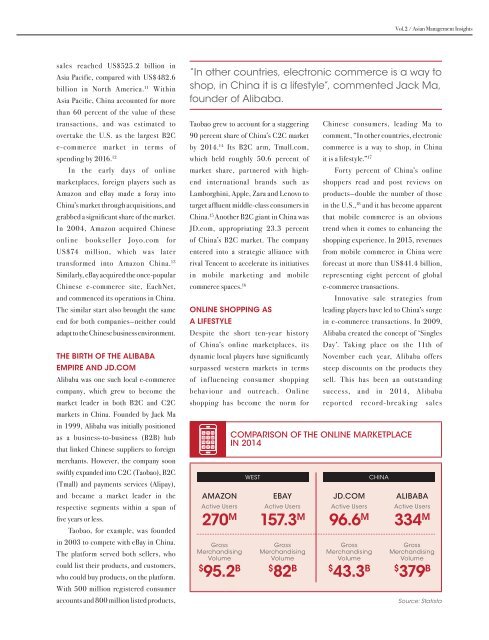SMU_AMI_November_Spread
You also want an ePaper? Increase the reach of your titles
YUMPU automatically turns print PDFs into web optimized ePapers that Google loves.
Vol.2 / Asian Management Insights<br />
sales reached US$525.2 billion in<br />
Asia Pacific, compared with US$482.6<br />
billion in North America. 11 Within<br />
Asia Pacific, China accounted for more<br />
than 60 percent of the value of these<br />
transactions, and was estimated to<br />
overtake the U.S. as the largest B2C<br />
e-commerce market in terms of<br />
spending by 2016. 12<br />
In the early days of online<br />
marketplaces, foreign players such as<br />
Amazon and eBay made a foray into<br />
China’s market through acquisitions, and<br />
grabbed a significant share of the market.<br />
In 2004, Amazon acquired Chinese<br />
online bookseller Joyo.com for<br />
US$74 million, which was later<br />
transformed into Amazon China. 13<br />
Similarly, eBay acquired the once-popular<br />
Chinese e-commerce site, EachNet,<br />
and commenced its operations in China.<br />
The similar start also brought the same<br />
end for both companies—neither could<br />
adapt to the Chinese business environment.<br />
The birth of the Alibaba<br />
empire and JD.com<br />
Alibaba was one such local e-commerce<br />
company, which grew to become the<br />
market leader in both B2C and C2C<br />
markets in China. Founded by Jack Ma<br />
in 1999, Alibaba was initially positioned<br />
as a business-to-business (B2B) hub<br />
that linked Chinese suppliers to foreign<br />
merchants. However, the company soon<br />
swiftly expanded into C2C (Taobao), B2C<br />
(Tmall) and payments services (Alipay),<br />
and became a market leader in the<br />
respective segments within a span of<br />
five years or less.<br />
Taobao, for example, was founded<br />
in 2003 to compete with eBay in China.<br />
The platform served both sellers, who<br />
could list their products, and customers,<br />
who could buy products, on the platform.<br />
With 500 million registered consumer<br />
accounts and 800 million listed products,<br />
“In other countries, electronic commerce is a way to<br />
shop, in China it is a lifestyle”, commented Jack Ma,<br />
founder of Alibaba.<br />
Taobao grew to account for a staggering<br />
90 percent share of China’s C2C market<br />
by 2014. 14 Its B2C arm, Tmall.com,<br />
which held roughly 50.6 percent of<br />
market share, partnered with highend<br />
international brands such as<br />
Lamborghini, Apple, Zara and Lenovo to<br />
target affluent middle-class consumers in<br />
China. 15 Another B2C giant in China was<br />
JD.com, appropriating 23.3 percent<br />
of China’s B2C market. The company<br />
entered into a strategic alliance with<br />
rival Tencent to accelerate its initiatives<br />
in mobile marketing and mobile<br />
commerce spaces. 16<br />
Online shopping as<br />
a lifestyle<br />
Despite the short ten-year history<br />
of China’s online marketplaces, its<br />
dynamic local players have significantly<br />
surpassed western markets in terms<br />
of influencing consumer shopping<br />
behaviour and outreach. Online<br />
shopping has become the norm for<br />
Comparison of the online marketplace<br />
in 2014<br />
WEST<br />
CHINA<br />
AMAZON Ebay JD.COM Alibaba<br />
Active Users Active Users Active Users Active Users<br />
270 M 157.3 M 96.6 m 334 m<br />
Gross<br />
Merchandising<br />
Volume<br />
$ 95.2 B<br />
Gross<br />
Merchandising<br />
Volume<br />
$<br />
82 B<br />
Chinese consumers, leading Ma to<br />
comment, “In other countries, electronic<br />
commerce is a way to shop, in China<br />
it is a lifestyle.” 17<br />
Forty percent of China’s online<br />
shoppers read and post reviews on<br />
products—double the number of those<br />
in the U.S., 18 and it has become apparent<br />
that mobile commerce is an obvious<br />
trend when it comes to enhancing the<br />
shopping experience. In 2015, revenues<br />
from mobile commerce in China were<br />
forecast at more than US$41.4 billion,<br />
representing eight percent of global<br />
e-commerce transactions.<br />
Innovative sale strategies from<br />
leading players have led to China’s surge<br />
in e-commerce transactions. In 2009,<br />
Alibaba created the concept of ‘Singles<br />
Day’. Taking place on the 11th of<br />
<strong>November</strong> each year, Alibaba offers<br />
steep discounts on the products they<br />
sell. This has been an outstanding<br />
success, and in 2014, Alibaba<br />
reported record-breaking sales<br />
Gross<br />
Merchandising<br />
Volume<br />
$ 43.3 B<br />
Gross<br />
Merchandising<br />
Volume<br />
$<br />
379 B<br />
Source: Statista


